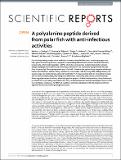| dc.contributor.author | Cardoso, Marlon H. | |
| dc.contributor.author | Ribeiro, Suzana M. | |
| dc.contributor.author | Felício, Mário R. | |
| dc.contributor.author | Gonçalves, Sónia | |
| dc.contributor.author | Matos, Carolina O. | |
| dc.contributor.author | Liao, Luciano M. | |
| dc.contributor.author | Santos, Nuno C. | |
| dc.contributor.author | Hancock, Robert E. W. | |
| dc.contributor.author | Franco, Octávio L. | |
| dc.contributor.author | Migliolo, Ludovico | |
| dc.contributor.author | Oliveira Nolasco Da Silva, Diego | |
| dc.contributor.author | de la Fuente Nunez, Cesar | |
| dc.date.accessioned | 2017-04-21T13:17:30Z | |
| dc.date.available | 2017-04-21T13:17:30Z | |
| dc.date.issued | 2016-02 | |
| dc.date.submitted | 2015-09 | |
| dc.identifier.issn | 2045-2322 | |
| dc.identifier.uri | http://hdl.handle.net/1721.1/108332 | |
| dc.description.abstract | Due to the growing concern about antibiotic-resistant microbial infections, increasing support has been given to new drug discovery programs. A promising alternative to counter bacterial infections includes the antimicrobial peptides (AMPs), which have emerged as model molecules for rational design strategies. Here we focused on the study of Pa-MAP 1.9, a rationally designed AMP derived from the polar fish Pleuronectes americanus. Pa-MAP 1.9 was active against Gram-negative planktonic bacteria and biofilms, without being cytotoxic to mammalian cells. By using AFM, leakage assays, CD spectroscopy and in silico tools, we found that Pa-MAP 1.9 may be acting both on intracellular targets and on the bacterial surface, also being more efficient at interacting with anionic LUVs mimicking Gram-negative bacterial surface, where this peptide adopts α-helical conformations, than cholesterol-enriched LUVs mimicking mammalian cells. Thus, as bacteria present varied physiological features that favor antibiotic-resistance, Pa-MAP 1.9 could be a promising candidate in the development of tools against infections caused by pathogenic bacteria. | en_US |
| dc.description.sponsorship | National Institute of Allergy and Infectious Diseases (U.S.) (R21AI098701) | en_US |
| dc.language.iso | en_US | |
| dc.publisher | Nature Publishing Group | en_US |
| dc.relation.isversionof | http://dx.doi.org/10.1038/srep21385 | en_US |
| dc.rights | Creative Commons Attribution | en_US |
| dc.rights.uri | http://creativecommons.org/licenses/by/4.0/ | en_US |
| dc.source | Nature Publishing Group | en_US |
| dc.title | A polyalanine peptide derived from polar fish with anti-infectious activities | en_US |
| dc.type | Article | en_US |
| dc.identifier.citation | Cardoso, Marlon H.; Ribeiro, Suzana M.; Nolasco, Diego O.; de la Fuente-Núñez, César; Felício, Mário R.; Gonçalves, Sónia; Matos, Carolina O. et al. “A Polyalanine Peptide Derived from Polar Fish with Anti-Infectious Activities.” Scientific Reports 6 (February 26, 2016): 21385. | en_US |
| dc.contributor.department | Massachusetts Institute of Technology. Research Laboratory of Electronics | en_US |
| dc.contributor.mitauthor | Oliveira Nolasco Da Silva, Diego | |
| dc.contributor.mitauthor | de la Fuente Nunez, Cesar | |
| dc.relation.journal | Scientific Reports | en_US |
| dc.eprint.version | Final published version | en_US |
| dc.type.uri | http://purl.org/eprint/type/JournalArticle | en_US |
| eprint.status | http://purl.org/eprint/status/PeerReviewed | en_US |
| dspace.orderedauthors | Cardoso, Marlon H.; Ribeiro, Suzana M.; Nolasco, Diego O.; de la Fuente-Núñez, César; Felício, Mário R.; Gonçalves, Sónia; Matos, Carolina O.; Liao, Luciano M.; Santos, Nuno C.; Hancock, Robert E. W.; Franco, Octávio L.; Migliolo, Ludovico | en_US |
| dspace.embargo.terms | N | en_US |
| mit.license | OPEN_ACCESS_POLICY | en_US |
| mit.metadata.status | Complete | |
